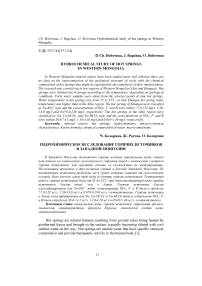Гидрохимическое исследование горячих источников в Западной Монголии
Автор: Болормаа Чимэддорж, Рагчаа Жигжид, Болормаа Оюунцэцэг
Журнал: Вестник Бурятского государственного университета. Химия. Физика @vestnik-bsu-chemistry-physics
Рубрика: Химия
Статья в выпуске: 1, 2016 года.
Бесплатный доступ
В Западной Монголии достаточно хорошо изучены минеральные воды, однако нет данных по взаимосвязи геологического строения пород с химическим составом горячих источников, что вероятно связано со сложностью их интерпретации. Исследование проведено в двух регионах (Алтай и Хангай) Западной Монголии. По температуре источники разделены на 6 групп, которые зависят от геологических условий. Было изучено сорок проб воды из девяти горячих источников. Температура воды в горячих источниках была от 23 до 55оС, при этом температура воды горячих источников Хангая выше, чем в Алтае. Горячие источники Хангая44классифицированы как Na-SO 2-типа, концентрации SiO2, F-и B были в пределах71.9-132 мг/л, 2.30-13.0 мг/л и 0.070-0.240 мг/л, соответственно. Горячие источники в Алтае классифицированы как Na, Ca-HCO3- и Na-НСО3 типа и содержание SiO2, F- и B были в пределах 38.6-74.1 мг/л, 1.10-4.10 мг/л и 0.010-1.46 мг/л, соответственно.
Минеральные воды, горячие источники, гидрохимия, формула курлова, физико- химические характеристики, химический состав воды, микрокомпоненты
Короткий адрес: https://sciup.org/148317755
IDR: 148317755
Текст научной статьи Гидрохимическое исследование горячих источников в Западной Монголии
Hot springs are natural features resulting from ground water being heated by geothermal forces and brought to the surface, typically becoming diluted with cool surface water on the way. Hot springs are natural water that have specific chemical composition and provide therapeutic activity in the human body [1].
Mongolia is surrounded by mountain ridges. The northwestern and central parts of Mongolia are highly mountainous forest regions, whereas the eastern part is a vast plain steppe and the southern part is a semi-desert [2].
The Khangai region consists of intensely deformed Carboniferous and Devonian sedimentary rocks intruded by huge bodies of granites and granodiorites from late Paleozoic and early Mesozoic periods. Numerous late Cenozoic, high potassium alkaline basaltic provinces are distributed throughout the Khangai area. Most of the hot springs are controlled by intersections of those types of fractures, faults and contact breccias zones between Carboniferous or Devonian sedimentary rocks and Permian-Triassic granitic rocks.
Mongolia is divided into four zones of hot springs as shown in fig. 1. In Western Mongolia, there are popular nine hot springs. The four of them are located in the Khovd and Bayan-Ulgii provinces, and the other five are in the Zavkhan province. Hot springs of Western Mongolia refer to the Altai and Khangai zones.
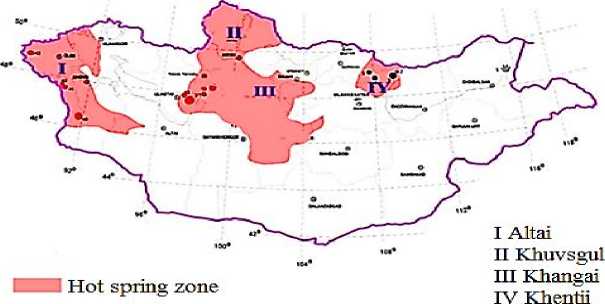
Fig. 1. Districts of hot springs in Mongolia
In view of the hydrogeological conditions, the observed area represents difficult systems of artesian basins, with inter-mountain hollows. Underground water was formed and accumulated in the crusts of weathering zone, but also in the porous collectors of the sedimentation cover [3].
Mongolia has approximately 250 spring waters (cold and hot) that provide Mongolian National Standard. They are hot springs with nitrogen gas, carbon dioxide gas and methane. 40 of 250 spring waters are located in Western part of Mongolia [1].
In Western Mongolia intensive research of water have been conducted, however hot springs have not been studied well due to the difficult geological conditions. Hot spring water is effected by many factors including anthropogenic and natural activity. Chemical analysis of hot springs revealed many important things that can be used to human health. The comparative studies of the Altai and Khangai regions have been not previously taken into account in Mongolia. The practical significance of this study will contribute to the basic materials of hot springs application.
The aim of this study was to identify water physico-chemical characteristics of spring waters in Western Mongolia and to evaluate chemical composition of spring waters.
Materials and methods
Totally 40 water samples were taken from the selected nine hot springs during 2014-2015 in Western Mongolia. Dissolved hydrogen of spring water was determined using dissolved hydrogen (DH) meter (ENH-1000, Japan). Some parameters such as temperature, pH, total dissolved solids (TDS), electrical conductivity (EC), salinity, oxidation reduction potential (ORP) and dissolved oxygen (DO) were measured in situ by using multiparameter instrument (Hanna HI9828, USA). Major ions (HCO 3 -, CO 3 2- , SO 4 2-, Na+, K+, Ca2+ and Mg2+) and biogenic elements (Fe total, Fe3+, NO 3 -, NO 2 - and PO 4 3-) of water were analyzed by titration and spectrophotometric methods. The physico-chemical variables were studied at the Laboratory of Environmental Studies of the National University of Mongolia using standard methods as appropriate. The microelements (Al, As, B, F, Cu and Pb) were investigated by inductively coupled plasma mass spectroscopy (ICP-MS). Triplicates of each analysis were performed and mean values were used for accuracy. The AquaChem and Watch software were used to calculate data of analysis. Sampling points and ID were expressed in table 1 and fig. 2.
Results and discussion
Physico-chemical parameters
There are 6 types of hot springs classified by surface temperature as follow: 0 0 C > hyper cold spring, 0 ° < cold spring < 4 ° С, cool spring < 20oC; 20oC < hypothermal spring < 30oC; 30oC ≤ thermal spring < 50oC; 50oC ≤ hyper thermal spring [3]. Hot springs temperatures as shown in fig. 3.
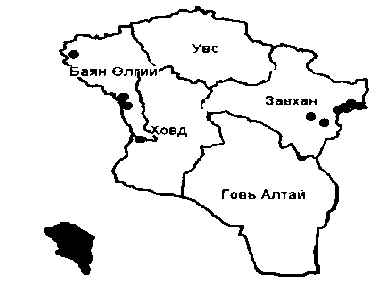
Fig. 2. Sampling points
|
Table 1. Sampling points and ID |
||
|
Regions |
Hot spring name |
Sample ID |
|
Khangai |
Otgontengerр |
O |
|
Ulaan khaalga |
UKh |
|
|
Khojuul |
Kh |
|
|
Zart |
Z |
|
|
Tsetsuuh |
Ts |
|
|
Altai |
Chihertei |
Ch |
|
Gants mod |
GM |
|
|
Aksu |
A |
|
|
Indert |
I |
|
In fig. 3 temperature of hot springs water ranged between 31-550C and 23-320C in the Khangai and Altai regions receptively. Most of hot springs water included temperature range of 20-37oC as similar to 76% of hot springs water sample.
As it is shown in fig. 4, the minimum values of EC, salinity and TDS were determined in Gants mod (GM) hot spring whereas the maximum values were
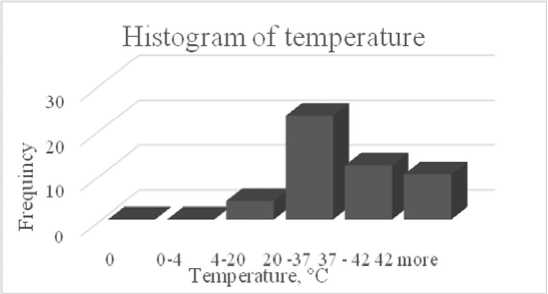
Fig. 3. Histogram of temperature
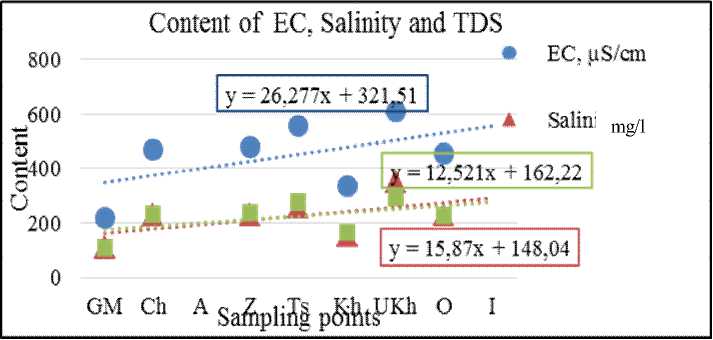
Fug. 4. Content of EC, Salinity and TDS of hot springs
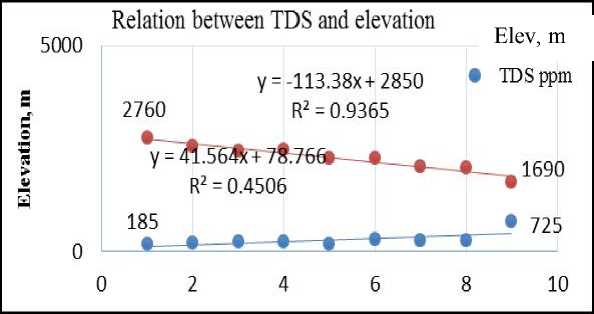
Fig. 5. Relation between TDS and elevation in hot springs of Western Mongolia detected in Indert (I) hot spring. The EC, Salinity and TDS were one of the major indicators of water quality that depends on basic ions in water.
In fig. 5 negative correlation between content of TDS and elevation was observed in all water samples. In Aksu hot spring that is located in the highest mountainous area (elevation 2760 m), the value of TDS was determined 185 mg/l whereas value of TDS in Inder hot spring (elevation 1690 m) was detected 725 mg/l.
Table 2
DO, DH and ORP сontents in hot springs
|
Regions |
ID |
DO, mg/l |
DH, mg/l |
ORP, mV |
|
Khangai |
O |
0.43 |
0.00 |
34.07 |
|
UKh |
0.62 |
0.00 |
40.45 |
|
|
Kh |
0.18 |
0.17 |
-1.58 |
|
|
Z |
0.19 |
0.22 |
-8.75 |
|
|
Ts |
0.14 |
0.24 |
-0.77 |
|
|
Altai |
Ch |
0.25 |
0.00 |
50.48 |
|
GM |
0.31 |
0.00 |
63.17 |
|
|
A |
ND |
ND |
ND |
|
|
I |
ND |
ND |
ND |
One of the major parameters of hot spring is oxidation reduction potential (ORP). ORP of underground water was ranged between -200 to +600 mV [4]. The contents of ORP were shown in Table 2.
The contents of DH that refer to ORP, was detected 0.220, 0.240 and 0.170 mg/l in Khojuul (Kh), Zart (Z) and Tsetsuuh (Ts) respectively. The negative values of ORP of these hot springs showed that spring water had reduced characteristics. Major ions
The Piper diagram used to describe the concentration or relative abundance of major constituents and the pattern of variability in water samples. The relative abundance of cations (Na++ K+, Ca2+, and Mg2+) is first plotted on the cation triangle. The relative abundance of Cl-, SO 4 2-, and HCO 3 -, CO 3 2- is then plotted on the anion triangle (fig. 5).
Chemical analysis of water gives information about health and it also helps in better understanding of the limits of water components in human body. It is also assimilate the level of pollution damaging the water system, aquatic plants and animals, and mostly humans who might use the water [5].
From the results of major ions in the Khangai region (fig. 5a), Ca2+, Mg2+, Na+, K+, CO 3 2-, HCO 3 -, Cl- and SO 4 2- were analyzed 1.00–6.68 mg/l, 1.21–29.0 mg/l, 52.5–131 mg/l, 1.70–4.87 mg/l, 4.41–35.8 mg/l, 17.27–89.5 mg/l, 1.91–399 mg/l and 13.52-101.87 mg/l respectively. The results showed that most of water samples included water classification of Na-SO 4 2-, Na-SO 4 2-, HCO 3 - in this area.
In fig. 5b, water samples were classified as Na-Na, Ca-HCO 3 -, Na-HCO 3 - in the Altai region. Concentrations of major cations Ca2+, Mg2+, Na+ and K+ in the Altai region were determined 1.00-24.0 mg/l, 0.00-7.20 mg/l, 22.8-200 mg/l and 1.00-22.0 mg/l respectively. CO 3 2-, HCO 3 -, Cl- and SO 4 2- ions were analyzed 0.0010.2 mg/l, 49.8-141 mg/l, 6.51-61.3 mg/l and 4.25-337 mg/l, respectively. Major ions in hot springs in Western Mongolia were investigated differently due to geological condition. Relation between Na+, SO 4 2- and SiO 2 in hot springs was illustrated in fig. 6.
a.
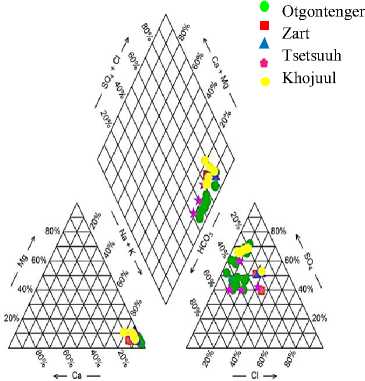
Fig. 5. Piper diagram of major ions in water. a. Khangai region, b. Altai region
b.
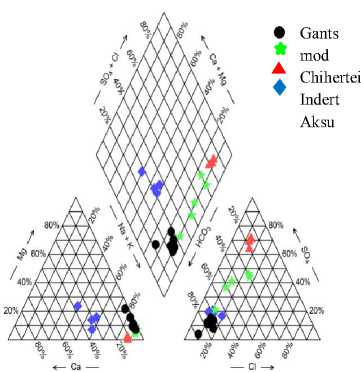
b.
a.
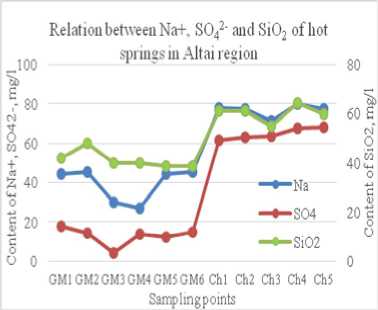
Fig. 6. Relation between Na+, SO 4 2- and SiO 2 in hot springs. a. Altai region, b. Khangai region
Relation between Na+ and SO42" of hot springs in Khangai region
150 ' 200
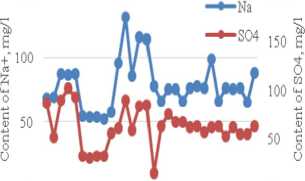
0 0
^ — СП(М^-М^-,ОМ'Г’ООООС|1Ч- N^IIDDDOOOOq QQ Samp ling points
Fig. 6 illustrates that Na+, SO 4 2- and SiO 2 of hot springs of all sampling points had linear relation between each other. In the Khangai region the concentrations of Na+ and SO 4 2- were higher than in the Altai region.
Major parameters of hot springs include temperature, pH, SiO 2 and sulfate ions. The hot springs have high concentration of Na+, SO 4 2- and SiO 2 . The mean values of temperature, pH and SiO 2 were shown in Table 3
Table 3
The average data of temperature, pH, TDS and SiO 2 in hot springs
|
ID |
T, °C |
pH |
SiO 2 |
TDS |
|
|
O |
55.0 |
9.46 |
71.9 |
226 |
|
|
00 CO 5 |
Z |
39.0 |
8.33 |
76.4 |
263 |
|
Ts |
31.0 |
8.18 |
112 |
276 |
|
|
Kh |
41.0 |
9.10 |
132 |
168 |
|
|
UKh |
38.0 |
8.20 |
92.8 |
293 |
|
|
GM |
27.0 |
8.55 |
41.1 |
206 |
|
|
Й |
I |
25.0 |
8.10 |
74.1 |
725 |
|
A |
32.0 |
7.86 |
38.6 |
185 |
|
|
Ch |
23.0 |
8.11 |
60.3 |
235 |
The chemical composition of 9 water samples is shown in Table 3. In the area under investigation, the water temperature of hot springs ranges from 23 to 55°C and the values pH from 8.1 to 9.4. It indicates alkaline characteristics. The total dissolved solids (TDS) are between 185 and 725 mg/l.
As shown in Table 3, high temperatures of water samples (between 31 and 550C) and high concentrations of Na+, SiO 2 and SO 4 2- in water samples from springs of the Khangai region suggest the contribution of mantle fluids into these springs.
Classification of thermal waters
Classification of thermal waters was carried out on the basis of relative contents of the three major anions Cl-SO 4 -HCO 3 and the diagram based on the relative concentration of Na+K, Ca and Mg as shown in fig. 7 [6]. In fig. 7a, different types of the thermal waters can be distinguished, such as peripheral or bicarbonate (HCO 3 -) waters. Sodium and potassium dominated in all the thermal springs as shown in Fig. 7b.
The ternary diagram is used to classify geothermal fluids based on the major anion concentrations. It helps to discern immature unstable waters and gives an initial indication of mixing relationships or geographic groupings [7]. The ternary diagrams were shown in fig. 7.
The major cation is sodium in fig. 7a. In fig. 7b, most of the samples are located within the region of high sulfate and hydrocarbonate and can be classified as peripheral waters that might be mixed with cold groundwater. In these cases the dominant ions are bicarbonate and sulphate. The waters were classified as bicarbonate and sodium types with a relatively high sulphate concentration and low chloride one typical of high-temperature systems.
2NaAlSi 2 O 3 + H 2 O + H 2 S + 4O 2 = H 2 Al 2 Si 2 O 3 + 4SiO 2 + 2Na+ + SO 2 2-:
The Chihertei (Ch) and Aksu (A) of the Altai region were classified as HCO 3 -and Na+ types. The water and rock interaction of this spring water were as follows:
2NaAlSi2O3+ 3H2O + CO2= H2Al2Si2O3⋅H2O + 4SiO2 + 2Na++ HCO3-+ OH- a.
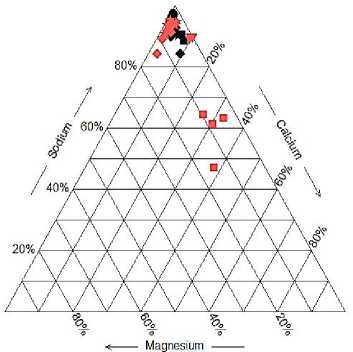
b.
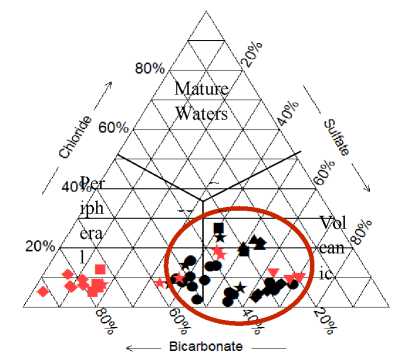
Fig. 7. Ternary diagram a. Na-K-Mg equilibrium diagram, b. Cl-SO 4 -HCO 3 ternary diagram
Chemical composition
In many countries, Kurlov formula is usually used to express chemical composition of spring water. The Kurlov formula evaluates chemical composition with the ions concentration less than 20% and spring water having specific component [1]. Chemical composition of hot springs were expressed by Kurlov formula.
Hot springs in Khangai region:
Otgontenger:
_ -.4-..огз.н..;- Н93б Т420С; F9.55;H4SiO4 73.1^5/1;
U.Z/Л МдЧА г ■ ч t *
Zart:
Мо ,63 = -^-^^...LU.-. Т39°С; F3.85;H4SiO476.4my/l;
Tsetsuuh:
Mo 276 = ^^-pH8.2; T39°C;F13.3; H4SiO4112^5/1;
Khojuul:
Mo 276 = c°3 3-7504:5 PH9.1; T41°C;F6.35; Н45Ю4132ту/1;
Ulaankhaalga:
M0n9g = CO^6SO^5 pH8.2;T38QC;F8.74H4SiO492.8rng/l;
Hot springs in Altai region
Gants mod:
Ma o06 = ^^^-pH8.55; T27°C;F11.2; Н45Ю441.2тп5Д
Indert:
Aksu:
Mn = Hcol65 pH8.65; T32°C; В 1.2; H4SiO, 38.6mg/1;
0185 Na54Ca31 r
Chihertei:
Mo азе = HCO»65 pH8.86; T23°C; F2.7; B1.4; H4SiO4 60.3z?zar/l;
°"‘35 Na54Ca31 r 4 4
Microelements
The elemental analysis was carried out in the acidified water samples using ICP-MS as shown in Table 4.
Table 4
Microelements of hot springs
|
Code |
AI |
Microelements, mg/l |
||||
|
As |
Cu |
Pb |
B |
F |
||
|
Ch |
0.23 |
0.030 |
0.00 |
0.00 |
0.67 |
1.9 |
|
GM |
0.030 |
0.030 |
0.04 |
0.03 |
0.010 |
11 |
|
A |
0.030 |
0.030 |
0.04 |
0.03 |
0.010 |
1.7 |
|
UKh |
0.13 |
0.010 |
0.08 |
0.01 |
0.24 |
13 |
|
Kh |
0.78 |
0.010 |
0.00 |
0.01 |
0.11 |
14 |
|
Z |
0.11 |
0.010 |
0.00 |
0.01 |
0.090 |
4.5 |
|
O |
1.8 |
0.010 |
0.00 |
0.01 |
0.29 |
10 |
The arsenic, copper and lead are presented at relatively low concentrations in these hot springs (< 0.08 mg/l). The content Al ranged from 0.030 to 1.8 mg/l in all water samples. They consist of silica, aluminous and calcareous materials various proportions. Through continuous contact with the spring water, these deposits have abstracted some of these rare alkali metals, through absorption from the spring waters [8]. The content of F was measured from 1.7 to 14 mg/l in all hot springs. Most of hot springs have high concentration of F, such hot springs with F more than 5 mg/l are probably nearly fluorite deposits in these regions. Leeman [9] found boron in very different geological environments, associated with the presence of volcanic rocks, geothermal processes, and with materials deposited in very saline environments. The concentration of boron varied from 0.010-0.67 mg/l in hot springs. Other authors assume that the elevated boron concentration in some connate waters is directly related to the content of K, Li, Mg, Sr and I [10]. The high values are recorded in thermal waters due to the alteration of volcanic rocks and hydrothermal activity [5, 11-12].
Conclusion
Chemical analysis of water samples from 9 hot springs located in Western Mongolia was used for interpretation. The following are the main conclusions of this study:
-
• The hot springs of Western Mongolia were classified as Ca-HCO 3 -, Na-HCO 3 - and Na-SO 4 2- types. The highest value of bicarbonate is dominated in Gants mod and Chihertei of the Altai region and classified as Na-HCO 3 -.
-
• Gants mod, Chihertei hot springs are located in the region of high bicarbonate or they can be classified as peripheral waters that might have been mixed with cold groundwater. These bicarbonate waters are found in the typical, non-volcanogenic, high-temperature systems.
-
• In the Khangai region, spring water classified as Na-SO 4 2- type is typical of the deep geothermal fluid found in most high-temperature (31-550С) systems.
-
• This water type indicates that spring waters are heated by hot magma and originate from volcanic activity.
-
• Furthermore, to deeply understand water and sediment interaction of spring water, sediment of spring water will be analyzed and discussed with chemical geothermometer.
Acknowledgements
I would like to thank the research group of the Laboratory of Environmental Studies, National University of Mongolia.
Список литературы Гидрохимическое исследование горячих источников в Западной Монголии
- Namnandorj O. Hot springs of Mongolia. Ulaanbaatar. - 1966. - V. 168. - 156 p.
- Dolgorjav O. Geochemical characterization of thermal fluids // Geothermal training programme, 2009. - V. 10. - P. 125-150
- Purevsuren D. G. T. Future geothermal survey // Study in Mongolia. International Geothermal Conference. - 2003. - P. 15-19.
- Pet-hiang S., Manop R. and Jarin T. The Characteristic and Classification of Hot Springs in Thailand // Proceedings World Geothermal Congress. - 2005. - P. 24-29.
- Delgado O. Hydrogeothermal modelling vs. inorganic chemical composition of thermal waters from the area of Carballino (NW Spain) // Hydrol. Earth Syst. Sci. - 2012. - V. 16. - P. 157-166.

